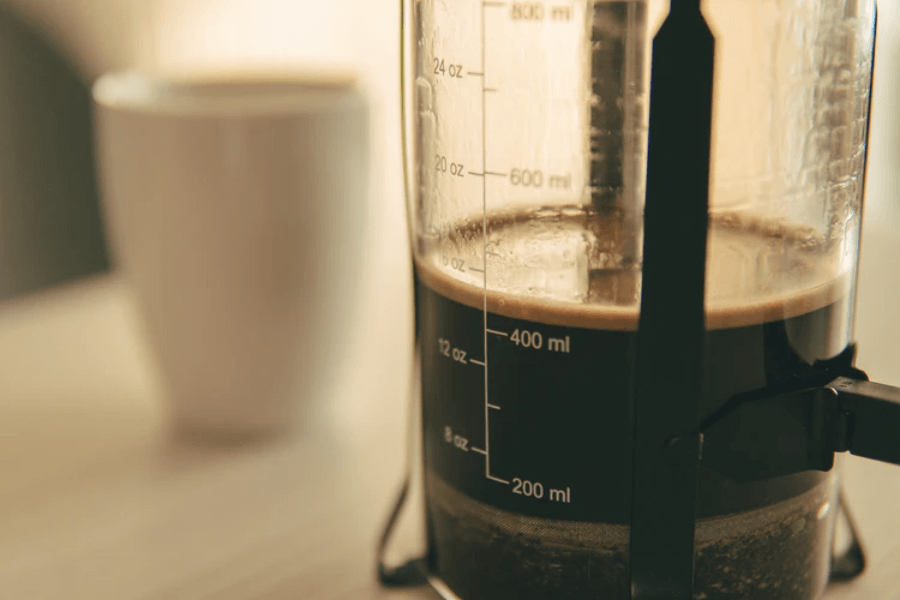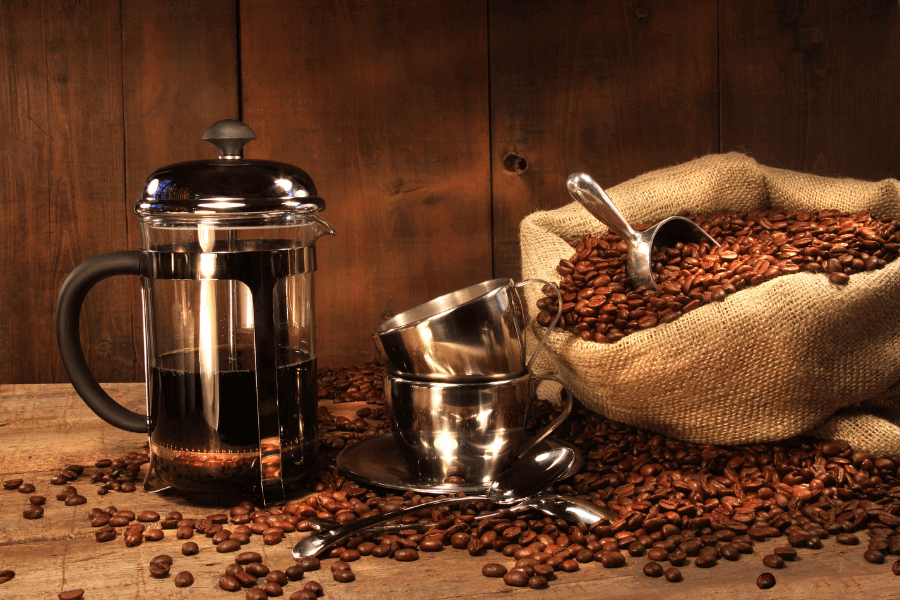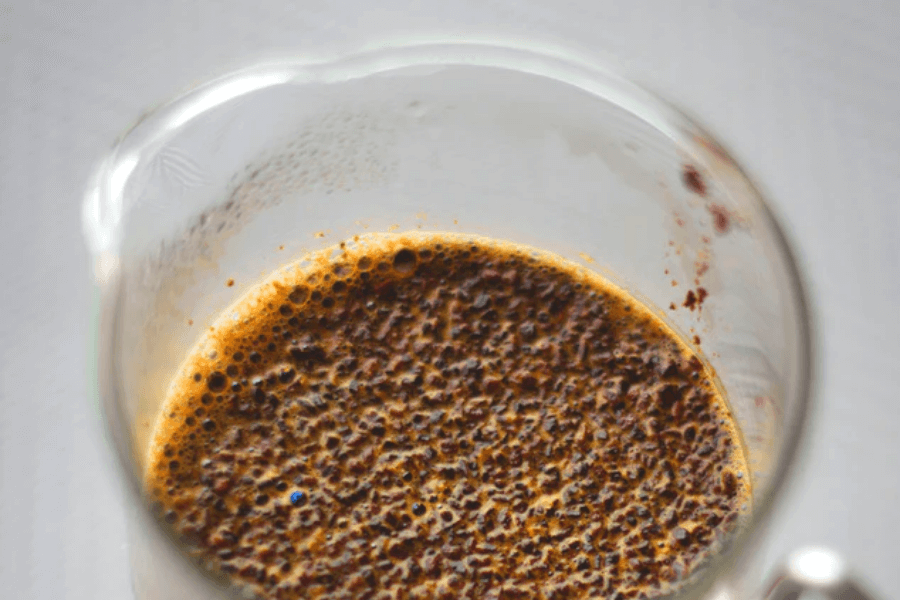How To Make Coffee With a French Press
Remember that scene in Harry Potter when Hermoine says to Ron, “Stop, stop, you’re going to take someone’s eye out, it’s leviOsa, not levioSAR”? That tiny difference in pronunciation is akin to French press brewing in many ways; get it slightly wrong and the outcome can be far from what you were expecting. Granted, no one’s eyes are going to get hurt, but your morning caffeine can take a hit.
The French press may seem like a simple coffee maker, but it’s deceptively complex.
There’s a science to this style of brewing, and nailing it can take your coffee from disappointing joe to cafe-quality cuppa.
I’m going to show you how to make coffee with a French press the correct — and best — way, so you’ll never have to drink subpar coffee again.
So, grab a notepad (you’ll need it), and let’s press on.
How Do French Press Coffee Makers Work?
French press coffee makers are immersion brewers, meaning that coffee grounds are left to steep in hot water during the brewing process. Once the water has sufficiently extracted the flavor, it passes through a filter that strains the coffee grinds from the joe.
Immersion brewing has its perks. It’s by far the simplest brewing method, is a relatively quick process, and you can control the specifics. For example, the strength of your coffee, your grind size, and the volume of your finished product.
Take a look at this video of bean buff James Hoffman explaining the differences between immersion brewing and percolation.
French press coffee makers stand out because they’re all-encompassing. You’ll mix your grounds, leave them to steep, and filter your coffee using the same vessel.
According to legend, the French press was invented in the 1800s and has remained popular ever since. The basic design, while improved and more sophisticated now, hasn’t changed much in the centuries since its invention, and for good reason. These coffee makers work well, and there’s no need to fix what’s not broken.

French Press Dos and Don’ts
Though the French press is a perennial favorite, the problem with manual immersion brewing is that it leaves room for guesswork. Most people wing it because it’s so easy to go by instinct. If you’ve been brewing this way, I’m sorry to tell you that it’s your first mistake.
Precision is the most important aspect of French press brewing, and this is where the chemistry comes in. I think the simplest way to show you how to make coffee using a French press the scientific way, is to tell you how not to brew.
DON’T Use Pre-Ground Coffee
I understand that coffee beans can be expensive and that not everyone has the means, patience, or desire to manually grind coffee every time they want a cuppa joe. However, the problem with pre-ground French press coffee is that it loses its freshness very quickly, even when sealed in foil. If you must use pre-ground coffee, choose a grind marked for use in a plunger, and keep your coffee sealed once opened.
DON’T Leave Leftovers in Your Carafe
It’s a mistake we’ve all made, I’m sure. We crave a cup of coffee and figure that we’ll make enough for later, then leave extra in our carafes. Why create extra dishes when your press is a perfectly good container, right?
This is sound logic, but you shouldn’t apply it to a French press for one simple reason:
Your grounds will remain in the carafe and will continue to steep, and in time will alter the profile of your brew. If you’ve ever gone back for round two and found that it was stronger, more acidic, or even unpalatable, this is why.
DON’T Use Boiling Water
It seems counterintuitive, but water fresh off the boil is a bad idea on two accounts. Firstly, it can ruin the taste of your coffee by bringing out all the acidity (and other harmful components). Secondly, some carafes — with an emphasis on cheaply made models — may weaken and eventually crack and break with frequent exposure to rapidly boiling water.
DON’T Rely on Guesswork
Amateur brewers often trust their eyes to gauge measurements. You can get away with it, of course, but that’s the reason your coffee’s flavor profile varies wildly from cup to cup.
Morgan Rease at Science Meets Food explains that a coffee’s profile is determined by the grounds and roast, the water to coffee ratio, water temperature, and extraction time. Change these variables, and your coffee’s quality will be altered, perhaps even dramatically.
You’re at full liberty to experiment until you find a formula that suits your tastes, but generally speaking, for excellent French press coffee at home, you should stick to the tried and tested formula.

Rules of Thumb for French Press Coffee
Are you ready to learn the secret to perfect plunging? Make a habit of the following and you’ll brew consistently excellent French press coffee.
Freshly Ground, Coarse Grinds Are the Way
You can use whichever roast you prefer, but for the reasons mentioned above, it’s best to manually grind your coffee when you’re ready to brew and not a moment before. Make sure that your grounds are coarse for the best results.
If you don’t have a grinder, why not check out our recommendations of the best coffee grinders. You might find one you like!
Just Add (Hot) Water
Boiling water may bring out all the nasty flavors, but cold water won’t bring out any flavor at all — unless you like the taste of wet sand. (If you do enjoy wet sand, please come see me, I just want to talk).
For French press coffee, experts recommend adding water that has been heated to 195 to 205 degrees Fahrenheit. This is more than sufficient for brewing, but not so hot that it kills your beans. As an added bonus, you won’t burn your tongue with the first sip!
Use the 1:15 Golden Ratio (and A Scale)
You’ll want to play around with quantities until you hit your sweet spot, but this ratio is unanimous among connoisseurs. When using a French press, your coffee to water ratio should be 1 gram of coffee for every 15 milliliters of water.
If you’re a perfectionist, a kitchen scale will go a long way. Without one, the best way to measure your water is by investing in a French press that has water level markings on its carafe.
Four Minutes Is All You Need
As with temperature, time can affect your coffee’s profile. Steep it for too long and you’ll end up with a bitter, acidic mess. Strain it too early, and your coffee will lack quality. If you’re wondering how to get the perfect middle — a prominent profile that isn’t too bold or saturated, it’s best to brew your French press coffee for four minutes total.
Experts agree that it’s enough time to extract all of the pleasant flavors and aromas from your beans.
Keep in mind that although this is recommended, it’s not a golden rule. If you prefer bolder coffee, go ahead and leave your grinds to steep for a little bit longer. But remember that the longer you leave your coffee to steep, the more pollutants will be extracted.
What You’ll Need
Before you can learn how to make French press coffee at home, you’ll need a few tools. Here’s what you should gather (or invest in) to make the most of your brewing:
- Your French press coffee maker, of course!
- A coffee grinder
- A kitchen scale (or alternative tool)
- A kettle or boiler
- A thermometer
- A timer
- A spoon
- Your coffee mug
- Milk and sugar (depending on preference)
How To Make the Best French Press Coffee: A Step By Step Guide
It’s time to brew. I promise you that although the science behind excellent French press coffee is a little complicated, putting it all into practice is the easiest thing in the world. So, without further ado, this is how to make French press coffee perfectly, every time.
Step One: Prepare Your Water, Grounds and Timer
You need to boil twice as much water as you’ll need for brewing (you’ll see why in step two), but you can kill two birds with one stone by weighing and grinding your beans while you wait for your water to heat. Don’t forget to set your timer to four minutes, Don’t hit “start” just yet — you’ll only need it to run when the water hits the grounds, but it’s a good idea to have it ready.

Step Two: Preheat Your Carafe
This simple trick will result in a more consistent brew as heat is lost while you wait for your grounds to steep, and brewing in a cold carafe catalyzes this. Pre-heating your carafe will ensure consistent temperatures at the beginning, so your coffee will brew evenly.
Remember that extra water I told you to boil? As soon as it’s ready, fill your carafe with this and leave it to stand for a minute or two. In the meantime, you can get on with step number three.
Step Three: Allow Your Brewing Water to Cool
While your carafe is warming up, let your remaining brewing water cool down to the ideal temperature of 93 degrees. Naturally, a thermometer is the best way to accurately gauge this, but if you don’t have one at hand, leaving your boiled water to stand for one to two minutes will do the trick.
Step Four: Empty Your Carafe
Once your brewing water has cooled to the desired temperature, discard the water inside the carafe. You won’t need it for anything but heating the carafe, so go ahead and chuck it out. Don’t worry about drying the carafe either. You’ll want to strike while the iron (or brewer) is hot.
Step Five: Insert Your Grounds and Ready Your Timer
Place your prepared grounds at the bottom of your carafe. Do so as neatly as possible. If there are any grounds stuck to the sides of the carafe — especially near the rim — they may interfere with the plunger.
You’ll need your timer ready to go for the next step, so make sure it’s at hand.
Step Six: Bloom Your Coffee
It’s time to mix your grounds, but don’t add all of your water just yet. You’ll want to bloom your coffee first, this releases carbon dioxide from your beans, which enhances the flavor of your finished product.
To do this, add just enough water to cover and immerse your grounds. Try to start your timer as soon as the water hits the coffee. Leave your grounds to bloom for a minute and a half.
Fun fact: Some connoisseurs advise stirring your coffee once it’s soaked to ensure even blooming, while others argue that doing this interferes with the suspension of the grounds and so disrupts extraction. There really is no way to tell who’s right here, so I say experiment and see what works best for you.
Step Seven: Fill Your Carafe
Now you can go ahead and add the rest of your water. Pour it as slowly and methodically as possible. If you choose to stir your grounds, do so gently and consistently. Some baristas note that you should give your brew a stir every minute or so, while others say to only stir at the beginning. Again, it’s a matter of preference so try it out and see which method you enjoy more.
Otherwise, if you are choosing not to stir your brew, leave it to steep until your timer sounds.
Step Eight: Skim Your Brew
You should include this step regardless of whether or not you stirred your brew.
After steeping, you may find that your coffee has developed a slimy, chunky layer floating right on top. Use a teaspoon to break it up with a brief stir. Remove any stubborn oils that remain by simply scooping them out of your brew and discarding them.

Step Nine: Press!
There really is no skill required. All you have to do is add your brewer’s lid, then push down on the plunger. Make sure that you press it down as far as it can go, which should be to the bottom of the carafe, just above your grounds.
The speed or force at which you press doesn’t really matter, beyond not damaging or breaking your French press. It’s more important to keep your grounds below the filter, so they won’t make their way up and into your coffee.
Step Ten: Decant
That’s it. Your French press coffee is ready to go. Don’t forget to decant all of your coffee to prevent soaked grounds from re-entering and tainting your brew.
Once you’ve served it, all that’s left to do is add sugar and milk to taste. Enjoy!
Top 5 French Press Coffee Tips
So, you now know how to make the best French press coffee at home, but your expertise doesn’t have to end there. Here are a few of my favorite tips and tricks that will up your brewing game even more:
- Filtered water will enhance your coffee’s profile. If you can use it, do!
- Slow and steady wins the race. Plunge and pour your brew slowly, so loose grinds don’t make it past the filter.
- After plunging, pour your coffee through a paper filter to remove any sneaky fine grounds that may have slipped into your brew.
- Rinse your carafe and reusable filter before or after every use. Doing so will ensure that residue from previous brews won’t pollute your fresh coffee.
- If you’d like a weaker brew, discard the water after blooming. Caffeine is one of the first qualities to extract, so by replacing the water after this step you’ll have somewhat decaffeinated coffee.
Conclusion
There’s more to learning how to use a French press than meets the eye. Though coffee plungers are simple devices, they’re brewers nonetheless, and that means like any other coffee maker, it’s a good idea to use them as intended.
The method I’ve shown you may seem overcomplicated and unnecessary, but resist the urge to take the lazy road and taste the difference!
Bad French press coffee shouldn’t exist, so if you know someone who could benefit from this guide, don’t forget to pass it on. And while we’re on that, here’s a question for you: Do you stir your brew, or leave it to steep as is?
I have some pressing matters to attend to, so I’ll see you in the next blog post. Happy brewing!

We’ve compiled a list of the best French Press coffee makers! Take a look:
French Press Coffee Maker FAQs
Are Regular or Fine Grounds Suitable for A French Press Coffee Maker?
The simple answer is no. As explained in the article, the filters included with French press coffee makers are intended for coarse grounds. While your coffee will still taste excellent if you use finer grounds, chances are sediment will end up in your joe, and brewing will be more of a hassle than it should be.
What Is the Best Coffee for French Press Brewing?
This is a matter of taste. So long as you follow the instructions for grinding fresh beans, you’re at full liberty to use whichever brand, roast, or flavor you prefer.
Does French Press Coffee Contain More Caffeine? Is it Stronger Than Regular Coffee?
As a matter of fact, yes. Studies show that one cup of French press coffee contains a higher caffeine content than a single shot of espresso.
Can You Use a French Press to Brew Tea?
It’s unconventional, but you absolutely can! Just make sure that your ground tea leaves are suitable for use with your filter.
Which Is the Best French Press Coffee Maker?
We’ve covered this in-depth. If you’d like to shop for the best French press coffee maker for you, take a look at our top picks here.





